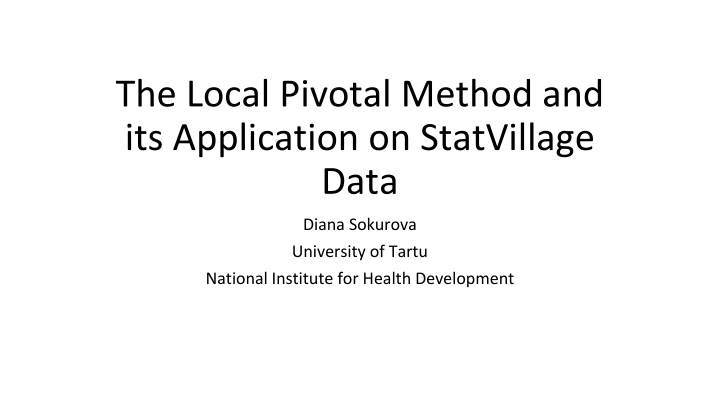
Survey Sampling Methods and Pivotal Techniques
Explore the world of survey sampling methods like simple random sampling and the pivotal method for accurate population parameter estimation. Learn about the Local Pivotal Method and its applications, including spatially balanced sampling techniques. Dive into the algorithm behind the pivotal method and its importance in statistical analysis.
Download Presentation

Please find below an Image/Link to download the presentation.
The content on the website is provided AS IS for your information and personal use only. It may not be sold, licensed, or shared on other websites without obtaining consent from the author. If you encounter any issues during the download, it is possible that the publisher has removed the file from their server.
You are allowed to download the files provided on this website for personal or commercial use, subject to the condition that they are used lawfully. All files are the property of their respective owners.
The content on the website is provided AS IS for your information and personal use only. It may not be sold, licensed, or shared on other websites without obtaining consent from the author.
E N D
Presentation Transcript
The Local Pivotal Method and its Application on StatVillage Data Diana Sokurova University of Tartu National Institute for Health Development
What is the Survey Sampling? The aim of a probabilistic survey sampling is to find out sampling strategy and the estimator that leads to the best estimate of a population parameter under interest.
Well-known sampling methods Simple Random Sampling Stratified sampling Stratified simple random sampling Systematic stratified sampling
What is Pivotal Method? Was introduced in 1998 by Deville, J.-C. & Till , Y. Unequal probability sampling without replacement through a splitting method The special case of splitting method Repetition Simplification
Algorithm 1. Pivotal Method 1. Choose two units ? and ? randomly, ?,? ?, where ? is the finite population. 2. Update the vector of their inclusion probabilities by the following updating rule. ?? 0,??+ ??,??? ??????????? ??+?? ,?? = If ??+ ??< 1, then ?? a. ????+?? ??+ ??,0 ,??? ??????????? 1 ?? 1,??+ ?? 1 ,??? ??????????? 2 ?? ?? ,?? = If ??+ ?? 1, then ?? b. 1 ?? ??+ ?? 1,1 ,??? ??????????? 2 ?? ?? 3. Repeat algorithm until all units are finished (i.e. equails to 0 or 1)
?? 0,??+ ??,??? ??????????? ??+ ?? ,?? = If ??+ ??< 1, then ?? ????+ ?? ??+ ??,0 ,??? ???????????
1?? 1,??+ ?? 1 ,??? ??????????? 2 ?? ?? ,?? = If ??+ ?? 1, then ?? 1 ?? ??+ ?? 1,1 ,??? ??????????? 2 ?? ??
The Local Pivotal Method Was introduced in 2012 by Grafstr m, A., Lundstr m, N. L. P. & Schelin, L. Spatially balanced sampling through the pivotal method The special case of the Pivotal Method Provides spatially balanced sampling Inclusion probabilities are updated according the same rule There is two different ways to choose two nearby units.
Algorithm 2: Local Pivotal Method I 1. Randomly choose one unit ?. 2. Choose unit ?, a nearest neighbour to ?. If two or more units have the same distance to ?, then randomly choose between them with equal probability 3. If ? has ? as its nearest neighbour, then update their inclusion probabilities according to the updating rule. Otherwise go to 1. 4. If all units are finished, then stop. Otherwise go to 1.
Algoritm 3:Local Pivotal Method II 1. Randomly choose one unit ?. 2. Choose unit ?, a nearest neighbour to ?. If two or more units have the same distance to ?, then randomly choose between them with equal probability 3. Update the inclusion probabilities for the units ? and ? according to the updating rule. 4. If all units are finished, then stop. Otherwise go to 1.
Simulation 1000 1 ??? ? = 1000 ?? ?=1 Monte-Carlo simulation Estimation of total Data is taken from StatVillage Study variables Continuous variable - household month income(moninch) Discrete variable household size(hhsize). Auxiliary variables Stratified Sampling - number of income recipients Local Pivotal Method the block and the house numbers from address of household and number of income recipients 1000 1 ???( ?) = ( ?? ??? ?)2 999 ?=1
Accuracy of continuous variable estimate Monte-Carlo standard error Sampling Method Simple Random Sampling 152 718.57 Stratified Random Sampling 139 327.05 Systematic stratified sampling 58 380.02 Random Pivotal Method 156 132.98 Local Pivotal Method I 50 190.02 Local Pivotal Method II 49 183.08
Accuracy of discrete variable estimate Monte-Carlo standard error Sampling Method Simple Random Sampling 73.22 Stratified Random Sampling 54.13 Systematic stratified sampling 51.15 Random Pivotal Method 71.17 Local Pivotal Method I 60.19 Local Pivotal Method II 58.42
Conclusion In the case of a continuous variable, both local pivotal methods provide more accurate estimates, and in this case, it is recommended to use local pivotal method II because it is more accurate and faster in execution. In the case of a discrete variable, each of the local pivotal methods did not provide any better estimates, and in this case, it is advisable to use a systematic stratified selection.






















